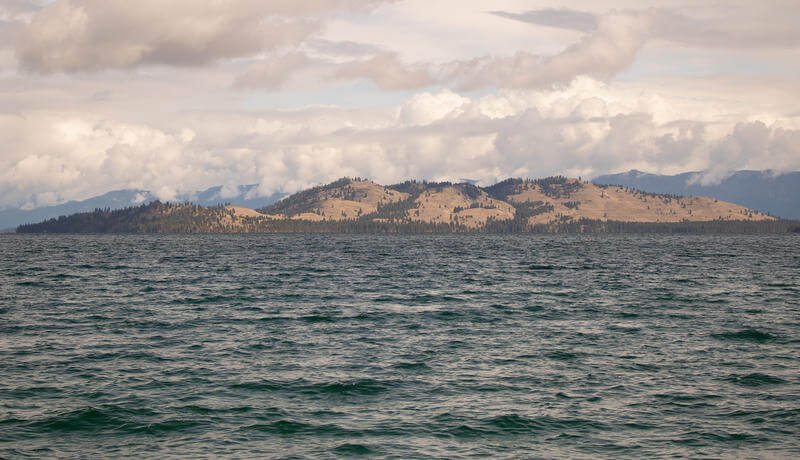Wild Horse Island
by Ruth Royter
Broadcast 11.5 and 11.8.2019

The wild horses of Wild Horse Island. Photo by Jack J. Hutchens (CC 2.0)
Listen:
Just the name – Wild Horse Island – sends the imagination soaring. The short boat trip to this island on the west side of Flathead Lake about ten miles north of Polson is magical. This is certainly not an area where humans have left nothing but footprints. Even the name suggests a story.
It may refer to one heard and then repeated by the members of the Stevens Survey team in 1855 as they were looking for a feasible route for a railroad across the Montana Territory. The Pend d’Oreille man who talked to Stevens said his father had had his horses stolen by the Blackfeet. In retaliation, he’d stolen a greater number of horses back from the Blackfeet, and had put them on the island.
The land on the island proved a harsh environment for year-round ranching and farming. Remnants of old buildings and an orchard are all that remain of the homesteading era.
In 1925, Reverend Robert Edington, a former parson from New York State who moved to Dayton, Montana, bought land on Wild Horse Island at an auction by the state of Montana to establish a girls’ camp where he entertained the campers and any adults who came with them. Begun in 1931, the dude ranch lasted until Mr. Edington was drowned during a storm in 1934. Mrs. Edington abandoned the enterprise and left the island, leaving some of their horses to run wild.
Lewis Penwell of Helena bought the Edington holdings and ran the dude ranch from 1938 to 1941, but without the Edingtons’ contacts with eastern dudes, the enterprise failed. Teaming with A. Lloyd Helmer, he then set out to acquire all the land on the island. They found a potential buyer in Dr. J.C. Burnett, a retired osteopath, who wanted the whole island on which to raise outstanding saddle horses and who insisted that the now-wild horses there be removed.
With a hired manager, the horse ranch ran until 1954, when a sale was held to reduce the herd. Mrs. Burnett, an heiress to the Timken roller bearing fortune, who had only visited the island once but who actually owned the property, died in 1956, leaving half of the land to her husband and half in trust to her brother and his heirs. Dr. Burnett died in 1959. Abandoned horses once more ran wild.
In 1960, the Rockefeller Foundation and the state of Montana proposed that the island should become public property. Lake County commissioners strongly opposed this, citing the loss of tax base to the county. To settle the Burnett estate, the Rockefeller Foundation proposed that they provide 70% of the asking price, leaving the state of Montana with an obligation of $79,500. The state had only $30,000 available and the proposal failed.
Next, R. Bourke MacDonald from Butte and his wife, Alice, purchased the island in 1961 and established cabin sites along the shore. 24 cabins now remain. Wildlife flourished and the now-wild horses gradually died off.
Not without wrangling and dissension, the Montana Department of Fish, Wildlife and Parks eventually gained control of the open space, and a state park was established. And can you see wild horses on Wild Horse Island? Yes! Several years ago, FWP transferred mustangs from wild herds in Utah to the island. At this moment, five horses inhabit their namesake island.

Wild Horse Island. Photo by Aaron Bolton.
Every week since 1991, Field Notes has inquired about Montana’s natural history. Field Notes are written by naturalists, students, and listeners about the puzzle-tree bark, eagle talons, woolly aphids, and giant puffballs of Western, Central and Southwestern Montana and aired weekly on Montana Public Radio.
Click here to read and listen to more Field Notes. Field Notes is available as a podcast! Subscribe on iTunes, Google Play, or wherever you listen to podcasts.
Interested in writing a Field Note? Contact Allison De Jong, Field Notes editor, at adejong [at] montananaturalist [dot] org or 406.327.0405.
Want to learn more about our programs as well as fun natural history facts and seasonal phenology? Sign up for our e-newsletter! You can also become a member and get discounts on our programs as well as free reciprocal admission to 300+ science centers in North America!












